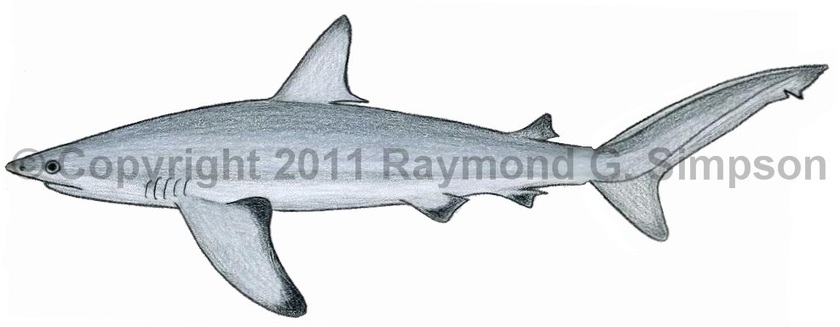
Common Name
Bignose Shark
Year Described
Springer, 1950
Identification
Anteroposterior tooth rows: 14-16/14-16 on each side; 31-34/29-31 total
Vertebrae: 101-110 precaudal, 194-206 total
A large and slender shark with a moderately large snout and a large eye. Distance between nostrils 1.3-1.4 times in pre-oral distance. Nasal flaps are broadly triangular. Upper labial furrows very short. A high interdorsal ridge is present. Long preanal ridge absent. No keels on caudal peduncle. Gill slits rather long (3.1-3.9% TL). Teeth in upper jaws triangular and erect (more oblique rearward), with serrated edges and high cusps. Lower jaw teeth thick-based and serrated, with slender, erect cusps. First dorsal fin fairly high (8.3-11.9% TL) with a straight anterior margin, and inserted over rear margin of pectoral fin. Second dorsal fin much smaller (2.8-3.4% TL) and inserted directly above anal fin. Both dorsal fins with extended free posterior tips (second dorsal free tip shorter than fin height). Anal fin similar in size to second dorsal fin. Pelvic fin origin behind free tip of first dorsal. Pectoral fin long, with a slightly concave posterior margin and an angular tip.
Color
Gray above and abruptly whitish below. Fins body color with dusky tips (except for pelvic fins). Inner tips of pectoral fins dark.
Size
Mature adults common from 216-280cm TL. Newborns from 70-90cm. Maximum size to over 300cm.
Habitat
Continental shelf and upper slope from 1-430m (usually 80-220m). Most common over the bottom in deeper water. Rarely nearshore or near the surface.
Range
Widely scattered records throughout the tropical western Atlantic: S. Florida, the Gulf of Mexico, the Caribbean Sea (continental and insular), northern S. America, and southeastern Brazil.
References
Castro, J.I. 2011. The Sharks of North America. Oxford University Press, 640 pp.
Compagno, L.J.V. 2002. Sharks. In: Carpenter, K.E. (Editor) FAO Identification Guide for Fishery Purposes. The Living Marine Resources of The Western Central Atlantic. Volume 1: Introduction, mollusks, crustaceans, hagfishes, sharks, batoid fishes, and chimaeras. ASIH Special Publication No. 5. FAO, Rome.
Compagno, L., M. Dando, and S. Fowler. 2005. Sharks of the World. Princeton University Press, 480 pp.